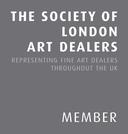The Woman with the Cigar

The Woman with the Cigar is a powerful oil painting of Katherine Dunham, a famous American dancer and choreographer. The scene is taken from her dance Caribbean Rhapsody. Dunham had spent two years travelling in the Caribbean studying all aspects of dance, and it was in Haiti that she became particularly inspired by the ethnographic field notes on Vodun rituals that she had made during her time there. Dunham drew on these to inform her Afro-Caribbean inspired dances which, to a predominantly European-dominated dance world, were ground-breaking both to audiences and critics alike.
The painting shows Dunham in an exotic costume and a headdress comprising a bird cage containing a bird of paradise with bright red tail feathers. The painting itself is characterised by contrasting shadows and highlights; whilst Katherine, who stands at the very centre, is illuminated by a bright yellow light (presumably a stage light) shining upwards from the floor, the surrounding scene is much darker and distinguished by muted green, blue and brown tones. In the top right hand corner, there appears to be a staircase, and behind Katherine are barrels and a person playing a classical guitar. The scene is strangely unsettling; whilst the murky nature of the painting’s background makes it difficult to make out the details, the viewer is drawn to Katherine, who stands assertively with a masculine cigar in her mouth, and her dress pulled up, displaying her leg to the audience in mid-dance. There is an air of frivolity too; the playfulness of Katherine’s performance is clear in her dramatic costume and elaborate headdress which she appears to be balancing on her head.
Doris Zinkeisen was born at Rosneath, Argyll, Scotland on 31 July 1898, daughter of Victor Zinkeisen (5 July 1863-30 October 1929), a timber merchant and amateur artist, and his wife Clara née Bolton-Charles (7 September 1869-1952), Doris’s younger sister was Anna Zinkeisen. In 1909, the family moved to Pinner, near Harrow and she studied at Harrow School of Art and in 1917 won a scholarship to the Royal Academy Schools, where she studied with her sister. Her first painting, a portrait of her sister Anna, was shown at the Royal Academy in 1918 which was painted by Doris when she was only aged 16.
Zinkeisen’s realist style made her popular as a portraitist and she became a well-known society painter. The subject matter of her paintings include society portraiture, equestrian portraiture, and scenes from the parks of London and Paris. These subjects moistly reflect the lifestyle of the upper class at that time. Early on she was taken up by the impresario Nigel Playfair (1874-1934), which led to a lifelong association with the theatre, and she worked with Charles Blake Cochran (1872-1951) and painted the portraits of many notable actresses including Anna Neagle and Evelyn Laye. She worked at the ‘Old Vic’ with Laurence Olivier and created his make-up for the film ‘Richard III’ and wrote her bible ‘Designing for the Stage’. A theatrical stage and costume designer, painter, commercial artist and writer, Doris was also a fine horsewoman, winning the Moscow Cup for the Supreme Hack Championship at the International Horse Show in 1934. Her paintings often feature horses and carriages in period settings and are noted for their clean draughtsmanship and unique palette.
At the end of the Second World War, she was the first artist to enter the infamous Belsen Concentration Camp and two of her painting are in the Imperial War Museum. Zinkeisen continued to work in London as a theatrical designer and held occasional exhibitions of her paintings, also designing the cover of a special edition of ‘Everybody’s Magazine’ to celebrate the coronation of Queen Elizabeth II in 1953 and the following year designed, amongst others, the scenery, and costumes for Noël Coward’s musical, ‘After the Ball’.
She married a naval officer Edward Grahame Johnstone in London in 1927. In 1928 their twin daughters Anne and Janet were born. Both daughters became artists. Doris and Edward also had a son, Murray Johnstone. Grahame Johnstone died in 1946 and Zinkeisen’s twin girls then lived with their mother, moving with her to Badingham, in 1966 where she died on 3 January 1991, aged 92.



